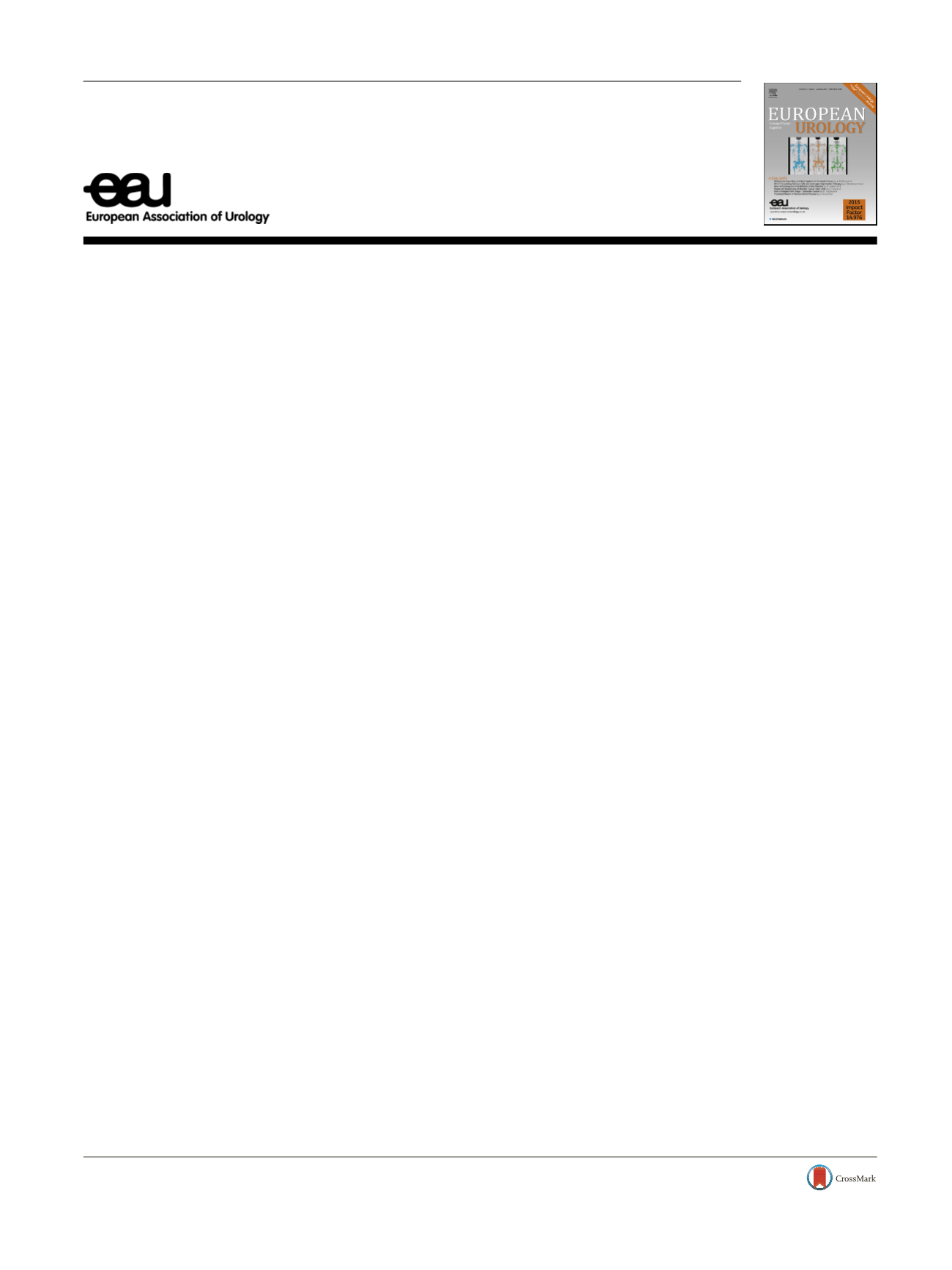

Platinum Priority – Editorial
Referring to the article published on pp. 888–896 of this issue
The Next Generation of Prostate Cancer Risk Calculators
Thomas Hermanns
* ,Ce´dric Poyet
Department of Urology, University Hospital Zu¨rich, University of Zu¨rich, Zu¨rich, Switzerland
Multivariable prediction models are superior to conven-
tional decision-making based solely on prostate-specific
antigen (PSA) testing or digital rectal examination (DRE) in
predicting the outcome of prostate biopsies
[1]. Therefore,
several prostate cancer risk calculators (RCs) have been
developed with the aim of minimizing the number of
unnecessary biopsies and reducing overdetection and
overtreatment of insignificant prostate cancer. External
validations have confirmed the utility of several RCs, and
thus their use in clinical practice is increasingly recom-
mended
[2].
However, the performance of current RCs is still
suboptimal, as evidenced by significant variation in RC
performance in different patient cohorts
[3]. Strategies to
improve current RCs include recalibration of existing RCs
to adjust for local cohort characteristics
[4]. Using data from
contemporary clinical cohorts to create novel RCs could be
another option for building more accurate up-to-date
decision aids. Including biomarker data or results from
multiparametric magnetic resonance imaging (mpMRI) are
further ways to potentially improve RC performance
[5].
In this issue of
European Urology
, Radtke and colleagues
[6]evaluate whether RCs using a combination of clinical
parameters and mpMRI data (ie, Prostate Imaging-Data and
Reporting System [PI-RADS] v.1.0 score) improves the
prediction of significant prostate cancer compared to PI-
RADS score alone or RCs based only on clinical parameters.
They used prospectively collected data for their patient
series of 1015 men (660 biopsy-naı¨ve and 355 prebiopsied
men) who underwent mpMRI before combined fusion
targeted biopsy and transperineal systematic saturation
biopsies to develop a risk model (RM) that included clinical
parameters and PI-RADS scores. Clinical parameters evalu-
ated for model inclusion were those already used for the RCs
of the Dutch arm of the ERSPC (RC3 for biopsy-naı¨ve men
and RC4 for prebiopsied men). Furthermore, they compared
the performance of their novel RM with the performance
of the original ERSPC RC3 and RC4, of the ERSPC RCs refitted
to their cohort characteristics, of a combination of the
original ERSPC RCs with PI-RADS scores, and of the PI-RADS
score alone.
Performance of their novel RM was good, with an area
under the receiver operating characteristic curve (AUC) of
0.83 for biopsy-naı¨ve men and 0.81 for prebiopsied men.
Furthermore, both models showed the highest rate of
reduction in unnecessary biopsies in decision analyses.
However, the performance of the original ERSPC RCs with
PI-RADS scores was comparable to their novel RM (AUC
0.84 for biopsy-naı¨ve and 0.78 for prebiopsied men). Both
models including clinical and PI-RADS data were superior to
the models including only clinical data (ERSPC RCs and
refitted ERSPC RCs) or PI-RADS score alone.
The authors are to be congratulated for their effort to
create a contemporary prostate cancer RC that includes
mpMRI data and is based on a current patient cohort
undergoing modern biopsy procedures. This is an important
step towards more precise risk prediction with the goal of
further reducing unnecessary biopsies and overdetection
and overtreatment of insignificant prostate cancer.
mpMRI is unique compared to other approaches as it
covers two important aspects that are useful for prostate
cancer risk assessment and diagnosis. First, it can identify
men who are likely or unlikely to have prostate cancer by
detecting or not detecting suspicious lesions in the prostate.
Second, it can improve the accuracy of prostate biopsies by
making cancerous lesions visible and thus targetable.
The utility of these two aspects of prostate MRI has
already been investigated. In a recent pilot study, Nam and
E U R O P E A N U R O L O G Y 7 2 ( 2 0 1 7 ) 8 9 7 – 8 9 8ava ilable at
www.sciencedirect.comjournal homepage:
www.eu ropeanurology.comDOI of original article:
http://dx.doi.org/10.1016/j.eururo.2017.03.039.
* Corresponding author. Department of Urology, University Hospital Zu¨ rich, Frauenklinikstrasse 10, 8091 Zu¨ rich, Switzerland. Tel. +41 44 2551111;
Fax: +41 44 2554555.
E-mail address:
thomas.hermanns@usz.ch(T. Hermanns).
http://dx.doi.org/10.1016/j.eururo.2017.05.0060302-2838/
#
2017 European Association of Urology. Published by Elsevier B.V. All rights reserved.
















